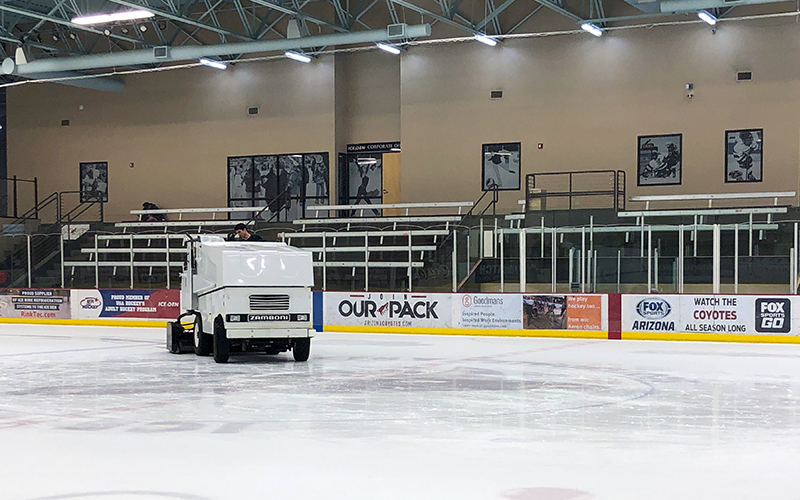SCOTTSDALE – Arizonans work hard to keep cool during the sizzling summers. The tactics aren’t as easy when trying to keep an 85-by-200-foot sheet of ice frozen.
For ice rinks in Arizona, the summer months create issues. The heat itself is problematic for the homes of ice skaters and hockey players in the desert, but not the most challenging complication, said the general manager of AZ Ice Peoria.
“We deal with stuff no one else deals with,” Jim Curley said. “The consistent high heat temperatures (and) when monsoons roll in, the amount of humidity. The dehumidification systems in these buildings that were all built between 10 to 20 years ago are hot dehumidification. They put more heat back in (to) the building while you take the humidity out.”
It makes maintaining the right temperatures a delicate balance.
Although Phoenix ranks second-to-last in overall humidity of major cities – 36.6 percent trailing only Las Vegas – its one-two punch with high heat creates complications. The average high temperature in July, for example, is 106.1 degrees, according to the National Weather Service.
Dehumidification is the process of removing moisture from the air to control humidity, often in commercial buildings and industrial processes.
“What people don’t realize is we still have humidity here, too,” Curley said. “You don’t feel it like you do in the East Coast, but it’s still here. That humidity functions negatively towards the ice with the heat.”
The Peoria facility isn’t alone in fighting the humidity the accompanies monsoons. The Ice Den rinks in Scottsdale and Chandler contend with another problem, said Matt Mendelsohn, the senior director of operations and procurement.
“We have a big issue with the glass starting to fog over,” Mendelsohn said. “You start to see fogging in the glass. Even though the facility was built with the foresight of the monsoon season, each rink has two dehumidifiers inside them.”
Another big issue with the heat is the price of the bill. Curley attempts to keep AZ Ice Peoria’s surface at 18 degrees during non-summer months and 21 degrees during the summer. In the building, he tries to maintain 30 percent humidity with a 58 degree temperature in the air.
In order to stay frozen, the surface of the ice rink must stay 24 degrees or lower. That means the temperature inside the facility usually hovers between 50 and 60 degrees, although that varies among buildings as those who regularly attend events will tell you.
The electric bill to create such conditions range from $14,000 to $15,000 monthly in the winter and $20,000 to $22,000 in the summer, Curley said. Add on the $8,000 to $9,000 water bill – it takes 12,000 to 15,000 gallons of water to create a surface – and your own bills probably don’t sound so bad.
The facilities are designed to contend with the heat, Mendelsohn said. At the Scottsdale location, the building is a tilt-panel construction, where thick pieces of concrete and steel are manufactured on the ground and then a crane tilts them up.
The tilting construction paired with 4 to 6 inches of foam acts as an insulator for the rink. The Ice Den in Chandler is a steel-framed building with about 12 inches of insulation joined by extra drywall.
In addition to the insulation, dehumidifiers can be found in all the rinks in the Phoenix area. It can still take days for the fog from the humidity to dissipate from the glass.
To manage that, the drivers of Zamboni ice resurfacing machines have to be careful in their judgment of how much water is added to the ice during their cuts.
Even with the preparation for the heat, every day is treated differently.
“Yesterday, we got 112 degrees, today we have 113 degrees,” Curley said. “We have to be careful in how we need to maintain the ice in summer months in the respect of not laying down too much water, not cutting too much ice, so, it’s a delicate balance where every 24 hours is different.”
It’s not magic that keeps ice rinks from turning into swimming pools. In reality, it’s a lot of planning and hard work.
Follow us on Instagram.
